外文翻译--经济活动、资源和组织关系:港口竞争力的关键因素((节选)
- 格式:doc
- 大小:44.00 KB
- 文档页数:6
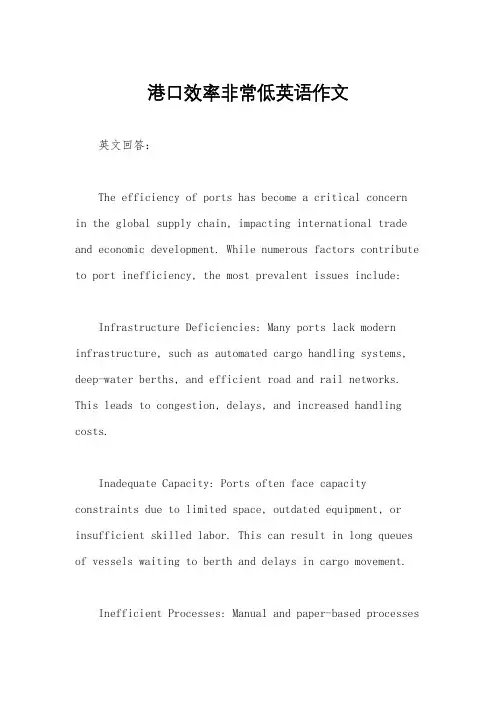
港口效率非常低英语作文英文回答:The efficiency of ports has become a critical concernin the global supply chain, impacting international trade and economic development. While numerous factors contribute to port inefficiency, the most prevalent issues include:Infrastructure Deficiencies: Many ports lack modern infrastructure, such as automated cargo handling systems, deep-water berths, and efficient road and rail networks. This leads to congestion, delays, and increased handling costs.Inadequate Capacity: Ports often face capacity constraints due to limited space, outdated equipment, or insufficient skilled labor. This can result in long queues of vessels waiting to berth and delays in cargo movement.Inefficient Processes: Manual and paper-based processesstill dominate many port operations, leading to errors, slow documentation, and inefficient communication. The lack of digitalization and automation hinders the smooth flow of cargo.Labor Disputes: Labor disputes, such as strikes and slowdowns, can significantly disrupt port operations. These disputes can arise from issues related to wages, working conditions, or union grievances.Lack of Coordination: Multiple stakeholders, including port authorities, shipping lines, freight forwarders, and customs agencies, often operate independently, leading to a lack of coordination and communication. This can result in delays and inefficiencies in cargo handling.Cybersecurity Threats: Ports are vulnerable to cybersecurity attacks that can disrupt operations, compromise sensitive data, and cause delays. The increasing use of technology in port operations makes them more susceptible to cyber threats.Addressing port inefficiency requires a comprehensive approach that involves:Infrastructure Investments: Governments and port authorities need to invest in modern infrastructure, including automated systems, deep-water berths, and improved road and rail connectivity. This will enhance port capacity and efficiency.Digitalization and Automation: Ports should embrace digitalization and automation technologies to streamline processes, reduce errors, and improve communication. This can include implementing electronic data interchange (EDI), automated cargo handling systems, and smart port technologies.Capacity Optimization: Ports can optimize their capacity through better planning and scheduling, vessel queuing management, and the use of simulation tools. This will help reduce congestion and improve cargo throughput.Improved Labor Relations: Maintaining positive laborrelations is crucial for efficient port operations. Governments and port authorities should foster dialogue between unions and management to address concerns and prevent disruptions.Effective Coordination: Stakeholder collaboration and coordination are essential for seamless port operations. Establishing clear communication channels and implementing collaborative platforms can improve information sharing and coordination.Cybersecurity Measures: Ports must implement robust cybersecurity measures to protect critical infrastructure and data from cyber threats. This includes regular security audits, incident response plans, and staff training.中文回答:港口效率低下。
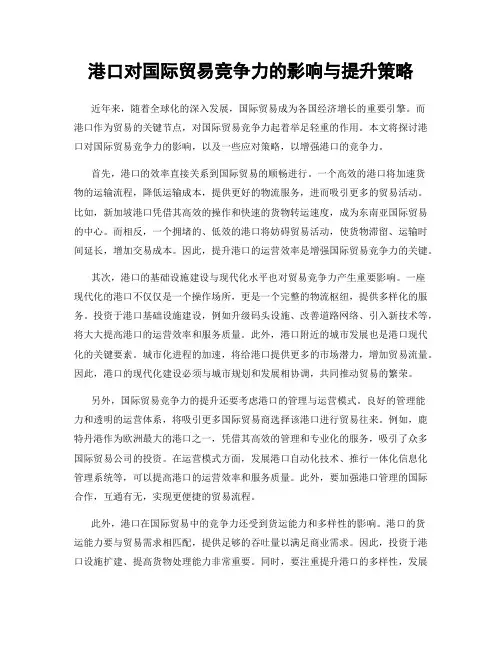
港口对国际贸易竞争力的影响与提升策略近年来,随着全球化的深入发展,国际贸易成为各国经济增长的重要引擎。
而港口作为贸易的关键节点,对国际贸易竞争力起着举足轻重的作用。
本文将探讨港口对国际贸易竞争力的影响,以及一些应对策略,以增强港口的竞争力。
首先,港口的效率直接关系到国际贸易的顺畅进行。
一个高效的港口将加速货物的运输流程,降低运输成本,提供更好的物流服务,进而吸引更多的贸易活动。
比如,新加坡港口凭借其高效的操作和快速的货物转运速度,成为东南亚国际贸易的中心。
而相反,一个拥堵的、低效的港口将妨碍贸易活动,使货物滞留、运输时间延长,增加交易成本。
因此,提升港口的运营效率是增强国际贸易竞争力的关键。
其次,港口的基础设施建设与现代化水平也对贸易竞争力产生重要影响。
一座现代化的港口不仅仅是一个操作场所,更是一个完整的物流枢纽,提供多样化的服务。
投资于港口基础设施建设,例如升级码头设施、改善道路网络、引入新技术等,将大大提高港口的运营效率和服务质量。
此外,港口附近的城市发展也是港口现代化的关键要素。
城市化进程的加速,将给港口提供更多的市场潜力,增加贸易流量。
因此,港口的现代化建设必须与城市规划和发展相协调,共同推动贸易的繁荣。
另外,国际贸易竞争力的提升还要考虑港口的管理与运营模式。
良好的管理能力和透明的运营体系,将吸引更多国际贸易商选择该港口进行贸易往来。
例如,鹿特丹港作为欧洲最大的港口之一,凭借其高效的管理和专业化的服务,吸引了众多国际贸易公司的投资。
在运营模式方面,发展港口自动化技术、推行一体化信息化管理系统等,可以提高港口的运营效率和服务质量。
此外,要加强港口管理的国际合作,互通有无,实现更便捷的贸易流程。
此外,港口在国际贸易中的竞争力还受到货运能力和多样性的影响。
港口的货运能力要与贸易需求相匹配,提供足够的吞吐量以满足商业需求。
因此,投资于港口设施扩建、提高货物处理能力非常重要。
同时,要注重提升港口的多样性,发展多种货物运输服务。
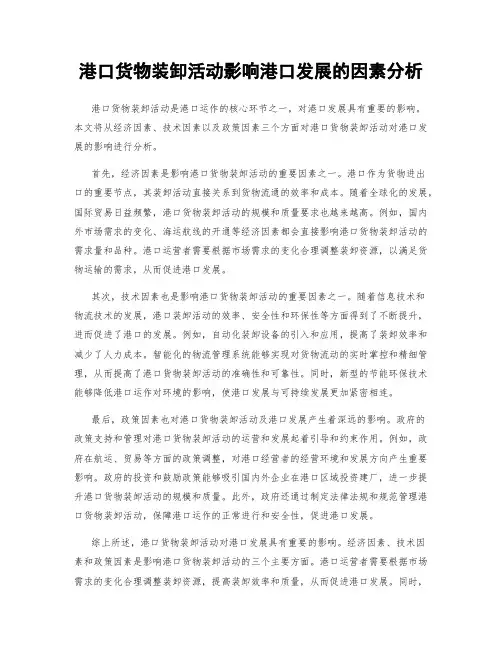
港口货物装卸活动影响港口发展的因素分析港口货物装卸活动是港口运作的核心环节之一,对港口发展具有重要的影响。
本文将从经济因素、技术因素以及政策因素三个方面对港口货物装卸活动对港口发展的影响进行分析。
首先,经济因素是影响港口货物装卸活动的重要因素之一。
港口作为货物进出口的重要节点,其装卸活动直接关系到货物流通的效率和成本。
随着全球化的发展,国际贸易日益频繁,港口货物装卸活动的规模和质量要求也越来越高。
例如,国内外市场需求的变化、海运航线的开通等经济因素都会直接影响港口货物装卸活动的需求量和品种。
港口运营者需要根据市场需求的变化合理调整装卸资源,以满足货物运输的需求,从而促进港口发展。
其次,技术因素也是影响港口货物装卸活动的重要因素之一。
随着信息技术和物流技术的发展,港口装卸活动的效率、安全性和环保性等方面得到了不断提升,进而促进了港口的发展。
例如,自动化装卸设备的引入和应用,提高了装卸效率和减少了人力成本。
智能化的物流管理系统能够实现对货物流动的实时掌控和精细管理,从而提高了港口货物装卸活动的准确性和可靠性。
同时,新型的节能环保技术能够降低港口运作对环境的影响,使港口发展与可持续发展更加紧密相连。
最后,政策因素也对港口货物装卸活动及港口发展产生着深远的影响。
政府的政策支持和管理对港口货物装卸活动的运营和发展起着引导和约束作用。
例如,政府在航运、贸易等方面的政策调整,对港口经营者的经营环境和发展方向产生重要影响。
政府的投资和鼓励政策能够吸引国内外企业在港口区域投资建厂,进一步提升港口货物装卸活动的规模和质量。
此外,政府还通过制定法律法规和规范管理港口货物装卸活动,保障港口运作的正常进行和安全性,促进港口发展。
综上所述,港口货物装卸活动对港口发展具有重要的影响。
经济因素、技术因素和政策因素是影响港口货物装卸活动的三个主要方面。
港口运营者需要根据市场需求的变化合理调整装卸资源,提高装卸效率和质量,从而促进港口发展。
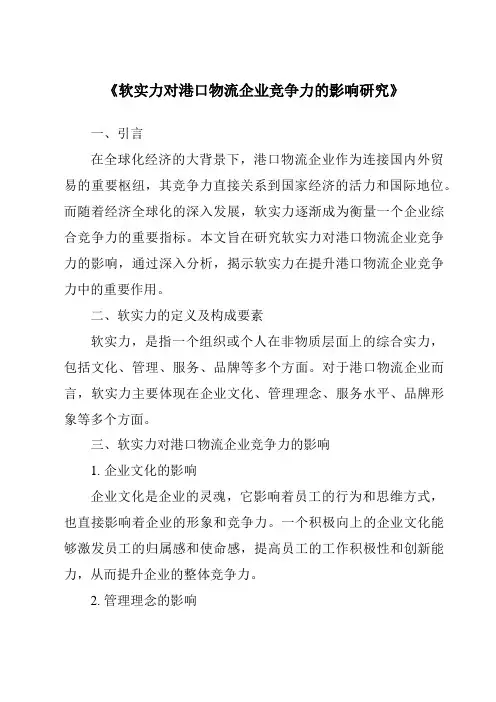
《软实力对港口物流企业竞争力的影响研究》一、引言在全球化经济的大背景下,港口物流企业作为连接国内外贸易的重要枢纽,其竞争力直接关系到国家经济的活力和国际地位。
而随着经济全球化的深入发展,软实力逐渐成为衡量一个企业综合竞争力的重要指标。
本文旨在研究软实力对港口物流企业竞争力的影响,通过深入分析,揭示软实力在提升港口物流企业竞争力中的重要作用。
二、软实力的定义及构成要素软实力,是指一个组织或个人在非物质层面上的综合实力,包括文化、管理、服务、品牌等多个方面。
对于港口物流企业而言,软实力主要体现在企业文化、管理理念、服务水平、品牌形象等多个方面。
三、软实力对港口物流企业竞争力的影响1. 企业文化的影响企业文化是企业的灵魂,它影响着员工的行为和思维方式,也直接影响着企业的形象和竞争力。
一个积极向上的企业文化能够激发员工的归属感和使命感,提高员工的工作积极性和创新能力,从而提升企业的整体竞争力。
2. 管理理念的影响管理理念是企业管理层对企业运营和发展的指导思想。
科学的管理理念能够使企业更加高效地运作,提高企业的运营效率和经济效益。
同时,先进的管理理念还能够吸引和培养高素质的人才,为企业的发展提供有力的人才保障。
3. 服务水平的影响服务水平是港口物流企业竞争力的重要组成部分。
优质的服务能够提高客户的满意度和忠诚度,为企业赢得良好的口碑和品牌形象。
同时,高效的服务流程和完善的售后服务体系还能够提高企业的运营效率和服务质量,从而提升企业的整体竞争力。
4. 品牌形象的影响品牌形象是企业在市场上的“名片”,它直接关系到企业的市场认可度和竞争力。
一个良好的品牌形象能够提高企业的知名度和美誉度,吸引更多的客户和合作伙伴。
同时,品牌形象还能够为企业带来更多的商业机会和资源,从而提升企业的整体竞争力。
四、提升港口物流企业软实力的策略1. 培育企业文化企业应积极培育积极向上的企业文化,通过加强员工的价值观教育、开展文化活动等方式,增强员工的归属感和使命感,提高员工的工作积极性和创新能力。
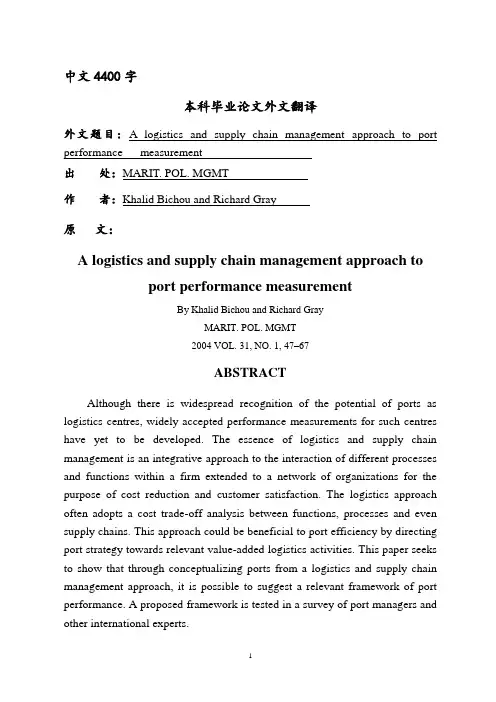
中文4400字本科毕业论文外文翻译外文题目:A logistics and supply chain management approach to port performance measurement出处:MARIT. POL. MGMT作者:Khalid Bichou and Richard Gray原文:A logistics and supply chain management approach toport performance measurementBy Khalid Bichou and Richard GrayMARIT. POL. MGMT2004VOL. 31, NO. 1, 47–67ABSTRACTAlthough there is widespread recognition of the potential of ports as logistics centres, widely accepted performance measurements for such centres have yet to be developed. The essence of logistics and supply chain management is an integrative approach to the interaction of different processes and functions within a firm extended to a network of organizations for the purpose of cost reduction and customer satisfaction. The logistics approach often adopts a cost trade-off analysis between functions, processes and even supply chains. This approach could be beneficial to port efficiency by directing port strategy towards relevant value-added logistics activities. This paper seeks to show that through conceptualizing ports from a logistics and supply chain management approach, it is possible to suggest a relevant framework of port performance. A proposed framework is tested in a survey of port managers and other international experts.IntroductionMeasures of port efficiency or performance indicators use a diverse range of techniques for assessment and analysis, but although many analytical tools and instruments exist, a problem arises when one tries to apply them to a range of ports and terminals. Ports are very dissimilar and even within a single port the current or potential activities can be broad in scope and nature, so that the choice of an appropriate tool of analysis is difficult. Organizational dissimilarity constitutes a serious limitation to enquiry, not only concerning what to measure but also how to measure. Furthermore, the concept of efficiency is vague and proves difficult to apply in a typical port organization extending across production, trading and service industries.Ports have an important role to play in the integration of all three types of channel. There are many organizations occupied (or potentially occupied) with logistics and supply chain integration within and around ports, mainly in the role of logistics channel facilitators (ocean carriers, land-based carriers, port operators, freight forwarders, port agents, etc.), but also as public institutions such as Customs authorities. This paper seeks to adopt an approach that incorporates within a valid framework of analysis existing measures of port performance and efficiency, the association of ports with logistics and supply chain management, and appropriate measures of logistics and supply chain management efficiency.Background literaturePort performance and efficiencyUNCTAD suggests two categories of port performance indicators: macro performance indicators quantifying aggregate port impacts on economic activity,and micro performance indicators evaluating input/output ratio measurements of port operations. In this paper, we focus on the micro level. Various references, particularly UNCTAD monographs, provide a range of port indicators by ratio type and category of operation. There are many ways of measuring port efficiency or productivity, although reducible to three broad categories: physical indicators, factor productivity indicators, and economic and financial indicators. Physical indicators generally refer to time measures and are mainly concerned with the ship (e.g. ship turnaround time, ship waiting time, berth occupancy rate, working time at berth).Sometimes, coordination with land modes of transport is measured, e.g. cargo dwell time or the time elapsed between cargo being unloaded from a ship until it leaves the port.Factor productivity indicators also tend to focus on the maritime side of the port,for example to measure both labour and capital required to load or unload goods from a ship. Similarly, economic and financial indicators are usually related to the sea access; for example, operating surplus or total income and expenditure related to gross registered tonnes (GRT) or net registered tonnes (NRT), or charge per twenty foot equivalent unit (TEU). Port impacts on the economy are sometimes measured to assess the economic and social impacts of a seaport on its respective hinterland or foreland. The results may be provided in port statistics, e.g. the port of Rotterdam or by research institutes such as ISEMAR in France.Many ports, particularly those in urban areas, have inadequate land-side connections. Land-side efficiency also needs to be addressed when ways are sought to expand port capacity. Port capacity is difficult to measure or even to define. It is, nevertheless, likely to be easier for a port to make better use of existing capacity rather than subsidize new transport infrastructure. A logistics and supply chain approach may achieve better use of port capacity.Port activities are usually measured by cargo output or through production functions. In the first case, the assessment of efficiency is based either on the contribution of a single factor productivity to port throughput such as output per worker or output per wharf, or on the measurement of total cargo handling productivity, where performance evaluation equates port operations to the production function. Much empirical research falls under this category and seeks to compare actual output to optimum output using the frontier method.Review of port literature relevant to logistics and supply chain management.In the port and shipping literature, few authors have addressed the issue of logistics and supply chain management within ports and across their network of organizations, and many published works adopt a fragmented approach to port operations.Although current literature recognizes the role of ports as integral components of distribution systems, many studies disaggregate total port operations and focus on single or a few elements of port activity. Literature on port logistics has only developed over the last two decades or so, for exampleby UNCTAD through a series of monographs on port management and operations, or the World Bank’s‘Port Reform Tool Kit’describing recent trends in port management and suggesting a framework for port reform and development. UNCTAD defines ‘third generation’ports as those offering value-added services (e.g. warehousing, packaging) in addition to cargo handling, and ‘fourth generation’ports as those that are separated geographically but with common operators or administration, such as by global multi-port companies [42]. In an effort to assess the logistics potential of ports, Harding and Juhel distinguish between general logistics services (GLS) and value-added activities or logistics (VAL), with the latter being a common feature of containerised and general cargo. They highlight the increasing role of ports as ‘distriparks’or dedicated areas for both GLS and VAL. They also point out the future of inland logistics centres or dry ports (e.g. inland container depots) for logistics operations that do not need to be carried out in the seaport area.Much of the literature advocating the future of ports as logistics centres highlights their nodal role in the changing patterns of maritime and intermodal transport (e.g. hub and spoke systems), but overlooks logistics integration of the various activities performed within the port organization itself. Most published articles address separately different aspects of port management (cost-analysis, marketing, strategic planning, etc.) without incorporating them into an integrated logistics framework of customer service, total costs or trade-off analysis. For instance, the question of the total cost that a cargo bears throughout different port operations up to the final customer or user does not appear to have been discussed in the academic literature. The same applies to competitive benchmarking between the management of seaports and that of other entities with similar operational features, e.g. airports or regional distribution centres.For some, this fragmented approach is mainly due to the complex organizational structure and management of ports, although recent port privatization schemes may have made it relatively easier to apply an integrative logistics approach to port operations. Fleming and Baird consider that the lack of a ‘competitive community spirit’among different port actors (e.g. customs authorities) is largely behind the difficulty of managing activities from a logistics perspective. The complex organizational structure of ports has always been a central issue in most aspects of port management, and probably constitutes themajor obstacle to the development of a comprehensive conceptual framework of port logistics management.Supply chain management extends the principle of logistics integration to all companies in the supply chain through strategic partnerships and cooperation arrangements. Some regard the next challenge of supply chain management is to manage ‘pliant flows’so as to ensure that all parts of the chain ‘oscillate together’in an holistic fashion. In similar vein, others stress the need for ‘agile’supply chains in order to survive in a rapidly changing global environment. Paixao and Marlow advocate the application of ‘agility’to the port environment, proposing that ports should be proactive rather than reactive along supply chains in a modern globalized world economy.Review of relevant logistics and supply chain measurementsMany techniques of logistics measurement adopt ratio instruments of financial reporting and productive efficiency. For instance, logistics performance is assessed through productivity and utilization measurement, or by applying the DEA model to international channel productivity. Most of the available logistics measurements correspond to a firm’s internal functions and processes. For example, a report by the European Logistics Association arranges logistics performance measurements into eight groups, but does not organize them into an integrative and comprehensive framework. Measurement techniques that have gained recognition from logistics professionals include activity-based costing (ABC) and total cost analysis (TCA). The former proposes an evaluation of the costs of a firm’s activities based on the actual resources and time consumed to perform them, whereas the latter proposes a trade-off analysis among different internal functions to minimize the total cost, while at the same time maintaining customer satisfaction.The use of TCA is extended to external logistics performance by integrating various flows and processes in the supply chain.In the area of supply chain management, the academic literature has been less successful in providing valid tools for performance measurement, and most performance measurements have been initiated by practitioners or consultants rather than through academic research. Exceptions include Kaplan and Norton who combine several dimensions of performance measurement. They provide a linear cause-and-effect model claimed to serve both measurement and management objectives. The Supply-Chain Operations Reference(SCOR) initiative undertaken by the Supply-Chain Council (SCC) attempts to integrate process reengineering, benchmarking, and process measurements into a cross-functional framework. Holmberg’s model proposes a conceptual framework of performance analysis throughout a systems approach to supply chain measurement. Process benchmarking is a technique that proposes the collaboration of all members in the supply chain for the purpose of process comparison and performance analysis. Institutions at the trade channel level can play a valuable and neutral role in benchmarking. Any valid performance model, within a logistics and supply chain management context, should integrate different measures of internal activities and link them to measurement activities of other entities in the supply chain.Towards a logistics and supply chain approach for portsFrom the above discussion, it appears that there may be a methodological difficulty in linking supply chain performance measurements to ports. Traditional port management is often typified by institutional fragmentation and conflict with other members of the logistics channel, whereas the supply chain management philosophy advocates process integration and partnership. A systemic approach to port performance is required. The systems approach should allow a neutral and objective perception of a problem’s definition and investigation, and particularly helps in overcoming the obstacles of channel identification and conflicting standpoints. However, despite successive attempts to apply the systems approach to operational problems in shipping and ports, very few would claim to apply the concept of systems thinking to the whole port organization.MethodologyAction researchThe methodology adopted for this study works within the action research paradigm. Action research is a process suitable where change is the main research subject, and the researcher participates in the change process. It requires a close relationship and collaboration between practitioners and researchers, made possible in the research described in this paper when one of the authors undertook a short-term appointment with the World Bank. Action research is most suitable for technique development or theory building, but isless suitable for hypothesis testing. Its advantage over traditional survey approaches is that the latter tend to be past-oriented or ‘snapshots’, whereas action research is a forward-looking process with implications beyond the immediate project. Action research is undertaken by using an appropriate intervention technique analogous to experimentation. The technique used in this approach is to present port managers and other experts with a model of port performance for examination and assessment by them, leading to an improved model. This technique is supported by a questionnaire of port managers focusing on performance indicators.Exploratory investigation into feasibility of port performance model As an exploratory investigation, individuals with different types of expertise related to ports were approached to comment on the relevance and feasibility of the proposed model, shown in figure 3 with covering notes (see appendix). The participants consisted of three panels of experts, namely:Analysis and resultsQuestionnaire responses and analysisThe questionnaire investigated current techniques of port performance measurement. The 45 respondent ports confirmed the regular use of combined indicators for both internal and external performance evaluation. As shown in table 2, financial measures are the most commonly used, closely followed by throughput measures for internal performance, whereas productivity and economic-impact indicators become more prominent for external comparison with other ports.Most ports were not satisfied with the current indicators (see table 3).However, when asked about logistics techniques for performance measurement and management over half of the ports replied that they use them very seldom or never (see table 4).Although responses may reflect a lack of interest in logistics operations and management, an alternative explanation may be the difficulty in understanding or applying logistics concepts and measurement techniques.Comments by expert panels on model validityFigure 3 and the appendix present a model applying logistics and supply chainmanagement concepts to port performance measurement. The model was sent to and discussed with different participants to assess its validity and feasibility within the context of port operations and management. Responses varied in many aspects, although all considered the model valid as a ‘first initiative’that looks at port efficiency from the perspective of logistics and supply chain management. The following sections present and analyse the responses by each of the three expert panels.ConclusionsThe research aims at conceptualizing the port system from the perspective of logistics and supply chain management, and suggesting a valid framework of efficiency measurement capable of reflecting the logistics scope of port operations and complementing, if not replacing, the conventional methods for port performance measurement and management biased towards sea access. By adopting a structured approach and methodology and involving a range of interest groups, the authors tried to ensure a valid and reliable inquiry given the time and cost constraints.The results show a common interest in logistics and supply chain management concepts across the various panels of experts. Respondents from the port group showed a lack of familiarity with logistics and supply chain management concepts, especially those related to logistics integration, benchmarking and channel design, although there is common recognition of ports as key logistics and distribution centres.译文:用港口物流及供应链管理方法来评价港口绩效Khalid Bichou and Richard Gray摘要尽管港口作为物流中心潜在能力已被广泛的认同,但还没有一个被大家广泛接受的性能测量标准出现。
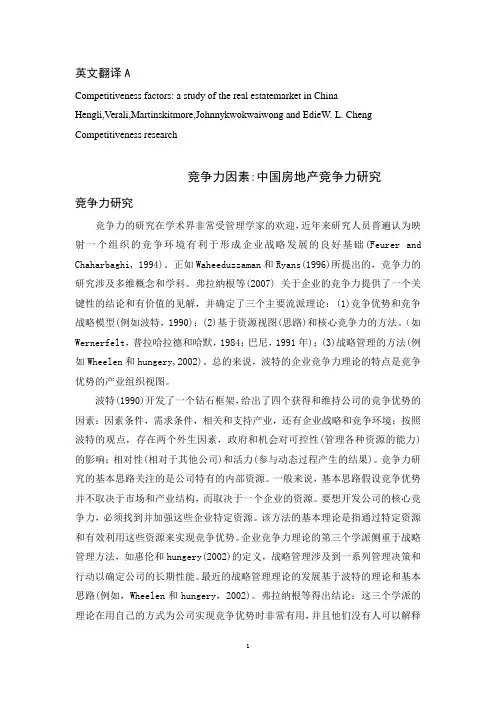
1 英文翻译A Competitiveness factors: a study of the real estatemarket in China Hengli,Verali,Martinskitmore,Johnnykwokwaiwong and EdieW. L. Cheng Competitiveness research
竞争力因素:中国房地产竞争力研究 竞争力研究 竞争力的研究在学术界非常受管理学家的欢迎,近年来研究人员普遍认为映射一个组织的竞争环境有利于形成企业战略发展的良好基础(Feurer and Chaharbaghi, 1994)。正如Waheeduzzaman和Ryans(1996)所提出的,竞争力的研究涉及多维概念和学科。弗拉纳根等(2007) 关于企业的竞争力提供了一个关键性的结论和有价值的见解,并确定了三个主要流派理论:(1)竞争优势和竞争战略模型(例如波特,1990);(2)基于资源视图(思路)和核心竞争力的方法。(如Wernerfelt,普拉哈拉德和哈默,1984;巴尼,1991年);(3)战略管理的方法(例如Wheelen和hungery,2002)。总的来说,波特的企业竞争力理论的特点是竞争优势的产业组织视图。 波特(1990)开发了一个钻石框架,给出了四个获得和维持公司的竞争优势的因素:因素条件,需求条件,相关和支持产业,还有企业战略和竞争环境;按照波特的观点,存在两个外生因素,政府和机会对可控性(管理各种资源的能力)的影响;相对性(相对于其他公司)和活力(参与动态过程产生的结果)。竞争力研究的基本思路关注的是公司特有的内部资源。一般来说,基本思路假设竞争优势并不取决于市场和产业结构,而取决于一个企业的资源。要想开发公司的核心竞争力,必须找到并加强这些企业特定资源。该方法的基本理论是指通过特定资源和有效利用这些资源来实现竞争优势。企业竞争力理论的第三个学派侧重于战略管理方法,如惠伦和hungery(2002)的定义,战略管理涉及到一系列管理决策和行动以确定公司的长期性能。最近的战略管理理论的发展基于波特的理论和基本思路(例如,Wheelen和hungery,2002)。弗拉纳根等得出结论:这三个学派的理论在用自己的方式为公司实现竞争优势时非常有用,并且他们没有人可以解释2
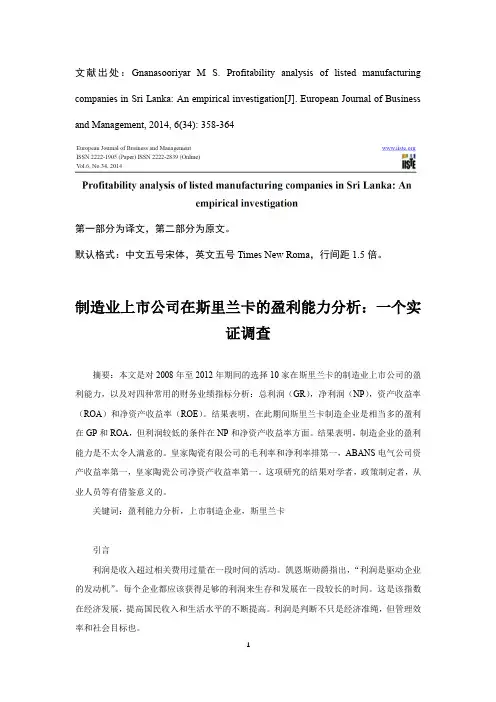
文献出处:Gnanasooriyar M S. Profitability analysis of listed manufacturing companies in Sri Lanka: An empirical investigation[J]. European Journal of Business and Management, 2014, 6(34): 358-364第一部分为译文,第二部分为原文。
默认格式:中文五号宋体,英文五号Times New Roma,行间距1.5倍。
制造业上市公司在斯里兰卡的盈利能力分析:一个实证调查摘要:本文是对2008年至2012年期间的选择10家在斯里兰卡的制造业上市公司的盈利能力,以及对四种常用的财务业绩指标分析:总利润(GR),净利润(NP),资产收益率(ROA)和净资产收益率(ROE)。
结果表明,在此期间斯里兰卡制造企业是相当多的盈利在GP和ROA,但利润较低的条件在NP和净资产收益率方面。
结果表明,制造企业的盈利能力是不太令人满意的。
皇家陶瓷有限公司的毛利率和净利率排第一,ABANS电气公司资产收益率第一,皇家陶瓷公司净资产收益率第一。
这项研究的结果对学者,政策制定者,从业人员等有借鉴意义的。
关键词:盈利能力分析,上市制造企业,斯里兰卡引言利润是收入超过相关费用过量在一段时间的活动。
凯恩斯勋爵指出,“利润是驱动企业的发动机”。
每个企业都应该获得足够的利润来生存和发展在一段较长的时间。
这是该指数在经济发展,提高国民收入和生活水平的不断提高。
利润是判断不只是经济准绳,但管理效率和社会目标也。
盈利手段,使利润从组织,公司,公司或企业的所有业务活动的能力。
它显示了如何有效地管理,可以通过使用所有市面上的资源赚取利润。
据Harward和厄普顿,“盈利是“赚其使用返回给定投资的能力。
”然而,长期的盈利能力“不是同义术语‘效率’。
利润率是效率的索引; 和被认为是效率和管理指南,更高的效率的量度。
中文2645字出处:De Martino M, Morvillo A. Activities, resources and inter-organizational relationships: key factors in port competitiveness[J]. Maritime Policy & Management, 2008, 35(6): 571-589.<文献翻译:原文>Activities, resources and inter-organizational relationships: key factors in port competitivenessDe Martino M, Morvillo AIn the last decade, the port economics literature has given great emphasis to the Supply Chain Management approach as the new paradigm for the definition of port competitiveness. SCM supports the development of partnerships between the actors of the supply chain and considers the integration of activities and resources along business processes as source of competitive advantage. Nevertheless, the application of SCM approach to the port is particularly compiex given the traditional hostile relationships between port actors. In the effort to overcome such complexity, some authors have considered ports as Logistics Service Providers and interpreted their role within supply chains through the integrative practices undertaken by Global Players –mainly Shipping Companies and Terminal Operators – in the supply of integrated logistics services. Even tough these actors are crucial for the port competitiveness, they determine a passive role of port in the new competitive scenario. The definition of a potential and pro-active role of port in the supply chains is the objective of this paper that presents, through a literature review on SCM and port competitiveness, a new framework for port competitiveness. According to this framework, that is based on the value constellation concept value is generated by joint effort of port actors in the satisfaction of clients’ needs, through t he exploitation of different I mterdependencies (serial, pooled and reciprocal) between supply chains. In this context, Port Authority has a I fundamental role in identifying those resources – the so called critical assets – that encourage the development of interorganisational relationships between port actors in the value generation process.1. IntroductionStudies on port competitiveness have traditionally focused on the analysis of specific services or port activities, within a context characterized by an increasing complexity, in which the actors involved are very often motivated by opposing interests and nonconvergent objectives.One of the most interesting attempt to describe and strategically drive the port development in Italy, uses the theoretical model created by Abell in order to delimit the sphere of competitiveness and define the strategic business areas (SBA) of a port. The final aim is to design a model for the definition of strategic positioning and the port’s development options, within eac h strategic area (SBA) of which it is composed. Various applications of this conceptual framework have brought to the formulation of strategic positioning hypothesis and development options for the Port of Genoa, Gioia Tauro, Savona Vado and Naples.With reference to the debate on who the true actors within the competitive arena are, Heaver believes that terminals are more clearly the focus of the competitive strategy and not ports, because of the different types of freight flows they deal with. Other authors have used a variant on the Porter diamond model to identify the main strengths and weaknesses of a port comparedwith other competitors. For a proper analysis of the competitive relationship between ports, they refer to the term’range’, i.e. an area t hat includes a series of ports, with a wide overlapping of hinterlands to serve the same clients. The proposed framework, applied to the Port of Antwerp in the Hamburg–Le Havre range, identifies a series of specific factors (demand conditions, factor conditions, supporting industries, etc.) that influence the provision of logistics services in the port and thus determine a competitive advantage respect to the ports in the same range.Other studies should also be mentioned, that are mainly based on an elaboration of different indicators of technical-dimensional features and performances of the infrastructures and the terminal’s equipment, so as to evaluate the competitive advantage of a port against its competitors.In summary, the above-mentioned literature proves rigorous and coherent respect to the theoretical models of reference, generally applied for the analysis of manufacturing industry. Furthermore, it has the merit for triggering the debate on port competitiveness that had long been completely neglected. However, these studies, although having brought to light the traditional conflict of the port community and the need to integrate a port and its hinterland, they have not dealt with the integration among actors as a source of competitive advantage in a systematic way.Consistent with the spread of the new paradigm by which ‘real competition is not company against company but rather supply chain against supply chain’ it has been stated that ‘competition is not unfolding between individual ports but between logistic chains’. Under this perspective, the supply of value-added services has gained a major role in the port competitiveness, within which terminals have become ‘simple elements’.The strategic importance of added-value logistics services as a source of competitive advantage of ports has been strongly supported by the two main agencies for international development: the World Bank and UNCTAD. In different statements, they refer to the opportunity of developing, alongside traditional logistics services—related to the movement of cargo—a whole set of added value activities that allow to optimize the flow of goods and increase the value of the product. They indeed highlight the necessity of a port to promote the development of its own productive hinterland, in order to guarantee a lasting economic development.The recognition of the supply chain management (SCM) as a lever for competitiveness, thus brings us to believe that the traditional approaches of analysis, briefly mentioned, are not enough to describe and interpret the current evolving market dynamics. As a result, a new systematic view is being affirmed, by which the competitiveness of a port, although still strongly related to structure-type variables (geo-economic context, institutional model and the infrastructures of connection), is increasingly dependent on software components of the port business, that include the range of services offered, the presence of ICT systems for the exchange of information between actors in the same and in other port communities, the know-how of the maritime industry, the level and intensity of relationships between actors: all elements that define the quality of a port.Accepting this view, some authors have reconsidered recent contributions and conceptual categories within supply chain management (SCM) literature to re-define strategic positioning and port strategies. In particular, the supply chain concept primarily focused on the logistics lincages between focal firm, supplier and customer, subsequently its contents expanded to include the network of organizations involved, through upstream and downstream linkages, in various processes and activities that create value in terms of products and services to the final client. SCM, as a managerial philosophy, supports the development of partnerships between actors of the supplychain and considers the integration of activities and resources of these actors along business processes as sources of competitive advantage.Although the strategic importance of the SCM and logistics integration is widely recognized in the academic world and in current business practice, only few contributions have, until now, dealt with logistics integration and SCM issues in the port environment, while most of the available literature adopts a fragmented approach in the analysis of port activities.Taking into consideration that the SCM is the new paradigm, by which ports can develop different competencies and offer a high quality service, this paper proposes a new theoretical framework for port strategy and development. To this aim, the paper is structured in three main parts. In the first part, of theoretical nature, there is an introduction of the SCM paradigm and its extension to networks. Networks are increasingly being looked at as an object of study within the SCM literature, as they more accurately describe the complex reality in which businesses operate. ‘The process in which raw materials are turned into end-products and services is rarely simple linear process chain, and much more like a spaghetti web of complex interconnected relationships’. In this context, the crucial factor for strategic positioning is the capability of a firm to create inter-organizational relationships, as they represent the means by which the company gains access to, mobilizes and combines different activities and resources, promoting and creating productivity and innovation, both within the business and in the network. The second part focuses on logistics integration and SCM issues in the port environment. This section of the paper is particularly outstanding as each concept has not been dealt with univocally in literature; from a review of these studies, it becomes evident that there is a lack of frameworks to represent the entire port community in the process of creating value.As the port is a complex reality involved in a series of supply chains, each of which is a specific entity with particular needs, networks make it possible to describe the relationships between port actors involved in the process of customer satisfaction; moreover, the inter-organizational relationships between the different network actors created, both to manage various business activities and to oversee critical resources in order to satisfy the clients, are decisive for port competitiveness. On the basis of this hypothesis, in the third part of the paper a new model is proposed According to this model, value is created by a joint effort of all port actors to satisfy the needs of target customers, through exploiting different interdependencies (sequential, pooled and reciprocal) between supply chains.<文献翻译:译文>经济活动、资源和组织关系:港口竞争力的关键因素在过去的10年里,港口经济学文献极大地强调了把供应链管理方式作为港口竞争力的新范式。